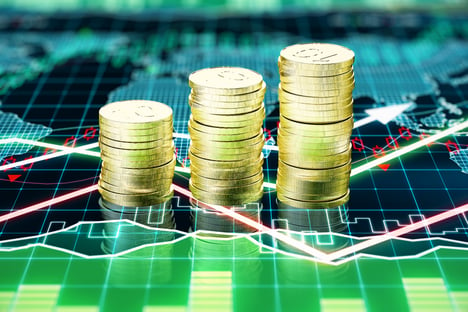
The relationship between two of the nation’s greatest investment arenas, the housing market and stock market, is much more complex than most Americans would expect. In fact, a recent study by CXO Advisory Group, a popular economic analyst company, found that there is no direct, causal relationship between the two—instead, they affect and are directed by the same macro and microeconomic factors. More specifically, they both follow the trends of an economic cycle, which represents the stages of expansion and contraction of the nation’s GDP.
To get a better understanding of the interplay between the two, let’s take a closer look at home prices and stock market productivity at each stage of the cycle.
Contraction
The contraction stage of the economic cycle is when the nation experiences a period of economic decline or negative growth. During this stage, rates are typically dwindling, commercial real estate prices fall, and financial leverage in the stock market weakens. A great example of the contraction stage is the crash of 2007, when millions of homeowners found themselves up to their ears in debt for investing in subprime mortgages they could no longer afford. With subprime lenders beginning to struggle, the Federal Reserve began adding liquidity to banks by selling its reserves and accepting subprime mortgages as collateral. As a result, the Treasury expected the nation’s GDP to continue to grow—clearly that was not the case.
In this stage, you can see how the declining housing market (and thus falling real estate prices) can indirectly affect the stock market by threatening a fall in the nation’s GDP. As homeowners struggle to pay their mortgages, consumer spending seriously declines. This means lending companies cannot afford to stay in business and investing in the stock market begins to slow.
Trough
The trough is the stage of the economic cycle when a downturn in economic activity, or “two consecutive quarters of declining GDP,” occurs. At this point in the cycle, rates are usually very low and real estate productivity is at its weakest, so many people are no longer willing or able to buy or sell stocks to cover their debt. As an example, let’s continue with the crash of 2007. After months of the Treasury purchasing toxic debt from subprime lenders, the nation’s GDP growth was at a standstill. By the end of January 2008, the economy had lost thousands of jobs and homeowners, so foreclosure rates dropped and the nation’s economy bottomed out. Then, in September of that year, the stock market fell 777.68 points—the largest point drop in history.
The trough stage provides a great example of the relationship between home prices and the stock market, as they both respond to the country’s contracting GDP. In this stage, home prices are the lowest due to the nation’s low demand (and ability to pay) for real estate. Similar to the drop in home prices, the sale of stocks seriously declines, as people are no longer willing to invest their capital in such a troubled economy.
Expansion
The expansion period is characterized by an increase in production capacity and employment, as well as a surge in the nation’s GDP. During this stage, home prices begin to rise and companies begin to grow and expand, allowing for more sales in the stock market. In fall 2008, for example, expansion began after the Federal Reserve accelerated its interest rate cuts and initiated its first series of large-scale purchase programs. Although the growth was exceptionally slow, low interest rates triggered development in the nation’s economy, thus stimulating the nation’s GDP. With this growth, more citizens began to re-evaluate their positions in the stock market.
As the expansion period highlights growth in the nation’s level of GDP, it’s clear that both home prices and stock market productivity rely on such development. With more government spending aimed at boosting the housing market, the nation-wide demand for homes rises, along with housing prices. In addition, this means consumer spending can increase and more people will begin to invest in the stock market.
Peak
The peak is the highest point of the economic cycle, when demand begins to level off as it reaches equilibrium. In most cases, this stage contains high real estate prices, major commercial building projects, and high stock market productivity. A great example in history of the peak occurred in 2011, when home prices nearly tripled since before the housing industry began its decline in 2007. In the first financial quarter of that same year, the stock market also hit its peak.
In the peak stage of the economic cycle, it’s clear that home prices and stock market productivity are both at their highest points. People have recovered and grown from the latest recession and the government has built enough housing to meet the demand of the economy.
Overall, it’s important to remember that although home prices and the stock market have a direct relationship, they do not directly impact one another. Instead, they both stimulate expansion or contraction in the nation’s GDP, which then directs the other. For more information about the housing industry, or to learn about financing a home in today’s market, contact one of our mortgage specialists today.


